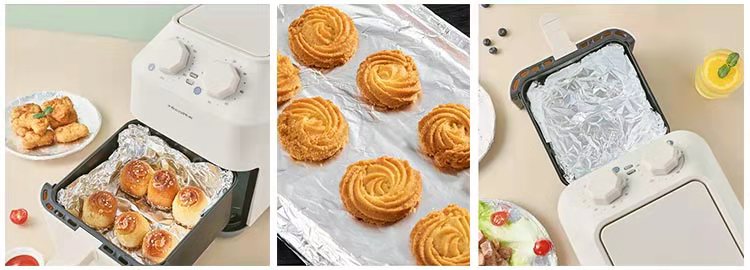 Because aluminum foil roll has a variety of properties, it is a very good packaging material that can be used for flexible food packaging, cosmetic packaging, industrial product packaging, as a roof insulation layer, creating food containers, etc.
Because aluminum foil roll has a variety of properties, it is a very good packaging material that can be used for flexible food packaging, cosmetic packaging, industrial product packaging, as a roof insulation layer, creating food containers, etc.
Rolls of aluminum foil are typically used to wrap things like snacks, candies, and drinks because they have good barrier characteristics and are moisture resistant. It keeps food fresh and keeps it from becoming bad.
Rolls of aluminum foil can be used as insulation in buildings to assist maintain consistent temperatures and save on energy costs due to its insulating qualities. Rolls of aluminum foil are also used to cover conduits and pipelines to stop heat loss.
Rolls of aluminum foil are utilized as packaging in a variety of industries due to their versatility and many other qualities. There are numerous uses for aluminum foil packaging materials, which are receiving more and more attention from consumers.
In order to better grasp the properties of the aluminum foil roll itself, which have many people extremely curious, let's first consider its weight.
Aluminium Foil Roll Weight
The weight of aluminum foil depends on the length, width, density and thickness of the aluminum foil. If there is a composite plastic film, you also need to know the density of the plastic to accurately calculate the weight of the aluminum foil. Film and the density of the glue to get the weight of the specific aluminum foil. Aluminum foil as a composite material is collectively referred to as the basis weight (ie basis weight).
Use the simplest and most direct The method is to use a microbalance to test the weight per square meter of the aluminum foil and then calculate the length of the total weight.
Method two, the known aluminum foil density is 2.71 (with 1mm thick aluminum foil as the standard), thickness 0.1mm, aluminum foil net weight 3KG, width 1000mm, calculation method: 0.1mm aluminum foil basis weight: 0.00271*100=0.271 per kilogram converted square meter: 1 (Referring to 1 kg)/0.271=3.69003690036 square meters/kg 3 kg: 3*3.69003690036=11.070110701 square meters, which is 3 kg=11.070110101 meters.
PTP medicinal aluminum foil weight calculation method
Theoretical single roll weight = (original aluminum foil thickness × aluminum foil density + coating agent dry weight) × specifications × length
(1) aluminum foil density: 2.7 × 103kg/m3
(2) coating agent dry weight: 0.006kg/m2 single-sided printing (Including overprinting) aluminum foil: 0.007kg/m2 double-sided printing aluminum foil: 0.008kg/m2 high coating amount (6~8g/m2) VC plain aluminum foil: 0.010kg/m2
(3) Give an example:: use 0.02mm original aluminum foil material is used to produce single-sided printing foil, which is cut into a roll with a width of 90mm and a length of 1000 meters. (0.020×10-3×2.7×103+0.007)×0.090×1000=5.49(kg)
(4) Variation formula length=aluminum foil weight/[(original aluminum foil thickness×aluminum foil density+coating agent drying amount)×specification] Area=Aluminum foil weight/(original aluminum foil thickness×aluminum foil density+dry amount of coating agent)
The weight of the aluminum foil roll depends on the length, width, density, and thickness of the aluminum foil. If there is a composite plastic film, you need to know the density of the plastic film and the density of the glue. Aluminum foil as a composite material is collectively referred to as the basis weight (ie basis weight). The direct method is to use a microbalance to test the weight per square meter of the aluminum foil and then convert the length of the total weight.
How Many Meters In One Ton Of Aluminum Foil ?
Aluminum foil product specifications: total thickness: panel thickness + corrugated core thickness (3mm-8mm) + bottom plate thickness
Aluminum foil rolls are gaining in importance in the packaging industry due to the growing demand for sustainable packaging options. Moreover, aluminum foil manufacturers pay more and more attention to the safety of aluminum foil rolls. Consumers have higher and higher requirements for food safety, environmental protection, and convenience. The aluminum foil rolls produced by HTMM aluminum foil manufacturers can fully meet any demanding requirements.
Why do you need to know the weight of an aluminum foil roll?
Material Quantity: Knowing the weight helps determine how much aluminum foil is present in a roll. This is important for both consumers and businesses to ensure they have an adequate supply for their needs.
Thickness and Strength: Heavier foil rolls often indicate a thicker and stronger material. This is essential for applications where the foil needs to provide robust protection or maintain its shape.
Cost Estimation: Weight is a factor in pricing. By knowing the weight of a foil roll, consumers and businesses can estimate costs more accurately, helping with budgeting.
Sustainability: Lightweight foil rolls are typically more eco-friendly as they use less material. This can be a consideration for those who are concerned about minimizing waste and environmental impact.
Packaging and Shipping: For manufacturers and suppliers, understanding the weight of foil rolls is essential for packaging and shipping logistics. It helps determine shipping costs, packaging materials, and handling requirements.
Cooking and Baking: In the kitchen, the weight of foil can affect cooking and baking. Heavier foil is less likely to tear or crumple under the weight of food, while lighter foil may be more convenient for everyday tasks.
Industrial Applications: In industrial settings, such as food packaging or insulation, the weight of the foil roll can impact the efficiency and performance of the application.
Customization: Some users may have specific requirements for the weight of foil rolls to suit their unique needs, and knowing the weight helps ensure they receive the right product.





.jpg)
